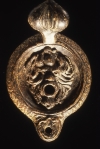 The Archeology has a very important place within the museum collections, and comprises specimens that constitute vestiges of early and late Bronze and Iron Ages in the Alentejo: polished stone axes, inscribed tombstones of the Bronze Age, Ceramics, arrow tips, etc. all are from the Roman period, and fill an important section, with memorial stones, classic capitals, bulls heads, numismatic, plain ceramics and sigillata land. Of the early late Bronze and Iron Ages are a significant quantity of pieces such as: pilasters, abutments, abacus and other architectural elements that are found in the section of the Museum’s Visigoth Nucleus, in the Santo Amaro Church; from the Arab period, which prove their presence, there are, although, just a few ceramic objects (carvings, lamps, dishes, bowls, vases) coins, moulds, thimbles, tombstones, and planks with Arab writings; of the medieval period are fragments of religious and civil buildings of Beja, including some heraldic and lapidary, where outstands the coat-of-arms of the infants D. Fernando and D. Beatriz, and a set of medieval discoid steles, sculpted in the region’s limestone.
The Archeology has a very important place within the museum collections, and comprises specimens that constitute vestiges of early and late Bronze and Iron Ages in the Alentejo: polished stone axes, inscribed tombstones of the Bronze Age, Ceramics, arrow tips, etc. all are from the Roman period, and fill an important section, with memorial stones, classic capitals, bulls heads, numismatic, plain ceramics and sigillata land. Of the early late Bronze and Iron Ages are a significant quantity of pieces such as: pilasters, abutments, abacus and other architectural elements that are found in the section of the Museum’s Visigoth Nucleus, in the Santo Amaro Church; from the Arab period, which prove their presence, there are, although, just a few ceramic objects (carvings, lamps, dishes, bowls, vases) coins, moulds, thimbles, tombstones, and planks with Arab writings; of the medieval period are fragments of religious and civil buildings of Beja, including some heraldic and lapidary, where outstands the coat-of-arms of the infants D. Fernando and D. Beatriz, and a set of medieval discoid steles, sculpted in the region’s limestone.
